S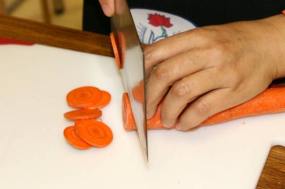 LICING: Holding the food and cleaver firmly, cut straight down, using the knuckles of your free hand as a guide.
LICING: Holding the food and cleaver firmly, cut straight down, using the knuckles of your free hand as a guide.
 JULIENNE: Stack a few slices, and use the slicing technique, cutting straight down through the stack to create sticks. For matchstick julienne, start with 1/8-inch slices, and cut them into 1/8-inch sticks.
JULIENNE: Stack a few slices, and use the slicing technique, cutting straight down through the stack to create sticks. For matchstick julienne, start with 1/8-inch slices, and cut them into 1/8-inch sticks.
 SHREDDING: Slicing herbs and leafy vegetables into long, thin strips. This method is especially useful for cooking tougher greens which can be hard to chew when left in bigger pieces. To shred a cabbage for coleslaw, cut a cleaned, washed head into quarters, remove the hard core, then thinly slice the quarters across the grain.
SHREDDING: Slicing herbs and leafy vegetables into long, thin strips. This method is especially useful for cooking tougher greens which can be hard to chew when left in bigger pieces. To shred a cabbage for coleslaw, cut a cleaned, washed head into quarters, remove the hard core, then thinly slice the quarters across the grain.
 ROLL CUTTING: This technique is used for long vegetables, like carrots or zucchini. It makes attractive chunks and exposes more of the surface area of the vegetable. Hold the blade perpendicular to the board and cut straight down on the diagonal. Then roll the vegetable a quarter-turn, and cut straight down again at the same diagonal angle. Continue rolling and cutting in this way all along the length of the vegetable.
ROLL CUTTING: This technique is used for long vegetables, like carrots or zucchini. It makes attractive chunks and exposes more of the surface area of the vegetable. Hold the blade perpendicular to the board and cut straight down on the diagonal. Then roll the vegetable a quarter-turn, and cut straight down again at the same diagonal angle. Continue rolling and cutting in this way all along the length of the vegetable.
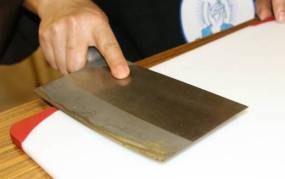 CRUSHING: To crush ginger, place it near the edge of the cutting board, lay the knife blade flat over it with the blade facing away from you, and with the heel of your free hand, give the side of the blade a good whack, being careful to avoid the edge of the blade.
CRUSHING: To crush ginger, place it near the edge of the cutting board, lay the knife blade flat over it with the blade facing away from you, and with the heel of your free hand, give the side of the blade a good whack, being careful to avoid the edge of the blade.
 PARALLEL CUTTING: Lay the food close to the edge of the board with the fingers of your free hand flat on top of it. Angle the Chinese chef’s knife so that it’s almost parallel to the board, slanting slightly downward. Move it slowly and carefully back and forth to slice the food, paying close attention to avoid cutting your fingers.
PARALLEL CUTTING: Lay the food close to the edge of the board with the fingers of your free hand flat on top of it. Angle the Chinese chef’s knife so that it’s almost parallel to the board, slanting slightly downward. Move it slowly and carefully back and forth to slice the food, paying close attention to avoid cutting your fingers.
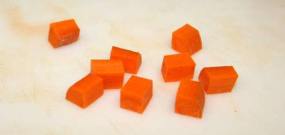 DICING: Line sticks up perpendicular to the blade, and slice straight down across them, creating cubes.
DICING: Line sticks up perpendicular to the blade, and slice straight down across them, creating cubes.
 BRUNOISE: Is to create very fine, confetti-like pieces. Stack the panels or lay them out, then cut them lengthwise into very thin julienne. Remember to keep your fingers tucked in, and out of the knife’s path. Finally, turn the julienne and chop them into a beautiful brunoise.
BRUNOISE: Is to create very fine, confetti-like pieces. Stack the panels or lay them out, then cut them lengthwise into very thin julienne. Remember to keep your fingers tucked in, and out of the knife’s path. Finally, turn the julienne and chop them into a beautiful brunoise.
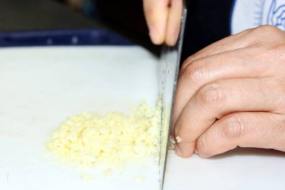 MINCING: Start by cutting the ingredient into thin strips, and then dice the strips. Using the tip as a pivot, raise and lower the blade in a chopping motion, moving it from side to side to mince everything evenly.
MINCING: Start by cutting the ingredient into thin strips, and then dice the strips. Using the tip as a pivot, raise and lower the blade in a chopping motion, moving it from side to side to mince everything evenly.
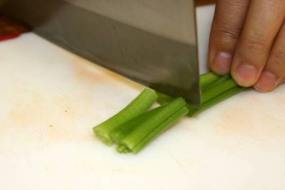 CHOP: Means to cut foods into pieces. This is a larger cut than dice. With a rocking motion, keeping the tip of the knife on the chopping board, slice down through the vegetable at regular intervals, using the full length of the knife.
CHOP: Means to cut foods into pieces. This is a larger cut than dice. With a rocking motion, keeping the tip of the knife on the chopping board, slice down through the vegetable at regular intervals, using the full length of the knife.
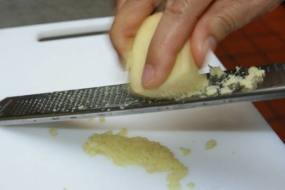 GRATE: Grate food into fine crumbs or other sizes depending upon your grater.
GRATE: Grate food into fine crumbs or other sizes depending upon your grater.
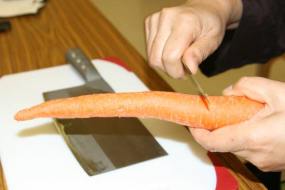 SHAVING: Different from peeling, shaving only removes a thin layer of the outer skin. This is a preferred technique for certain vegetables such as gobo.
SHAVING: Different from peeling, shaving only removes a thin layer of the outer skin. This is a preferred technique for certain vegetables such as gobo.
 FLOWER CUT: Includes using special tools and scoring techniques to create unique patterns. This creates fun, creative and beautiful dishes.
FLOWER CUT: Includes using special tools and scoring techniques to create unique patterns. This creates fun, creative and beautiful dishes.
